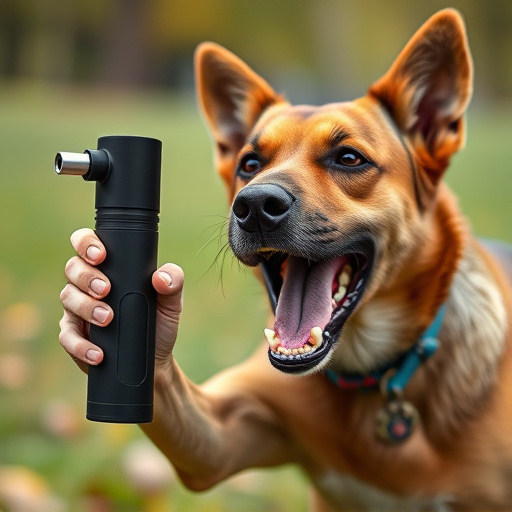Capsaicin-based dog sprays, approved for non-lethal animal control, vary widely in capsaicin content (1%-20%), affecting effectiveness and potential risks. A Dog Spray Capsaicin Content Comparison is crucial to select legal, suitable products based on intended use while adhering to local regulations, which dictate OTC status, concentration limits, age restrictions, and storage guidelines. Concentrations range from 0.5% for training aids to 10% for protective sprays, with understanding these differences key to safe, effective usage.
“Unleashing control with a keen understanding of animal control spray is essential, especially when focusing on capsaicin, the active ingredient. This article serves as your guide through the intricate web of capsaicin’s legal status and its pivotal role in dog sprays. We’ll dissect the varying capsaicin content in commercial products, explore their impact, and navigate the legal considerations surrounding their use. By delving into a comparative analysis of available sprays, readers will gain insights into ensuring effective yet compliant animal deterrence.”
- Understanding Capsaicin and Its Legal Status in Animal Control Spray
- Dog Spray: Unpacking the Capsaicin Content and Its Impact
- Legal Considerations: Navigating Regulations for Animal Control Spray Use
- Comparative Analysis of Commercially Available Dog Spray Capsaicin Content
Understanding Capsaicin and Its Legal Status in Animal Control Spray
Capsaicin, the active ingredient in chili peppers, has gained significant attention for its use in animal control sprays. This natural compound is known for its pungent properties and has been a subject of interest for non-lethal deterrents. In terms of legal status, capsaicin-based sprays are generally considered safe and effective, making them a popular choice for both professional and personal use. Its legal approval stems from extensive research and testing that demonstrate its minimal harm to animals and humans when used correctly.
When comparing dog spray capsaicin content, it’s crucial to understand the concentration levels. Different brands and products vary in their capsaicin concentrations, which directly impacts the spray’s potency. A thorough comparison of capsaicin content is essential for consumers to make informed decisions. Additionally, understanding local regulations regarding the possession and use of such sprays is vital to ensure compliance with legal requirements.
Dog Spray: Unpacking the Capsaicin Content and Its Impact
Dog spray, also known as pepper spray for dogs, is a controversial yet widely used tool in animal control. At the heart of its effectiveness lies the capsaicin content, a compound derived from chili peppers. The capsaicin content in dog spray varies significantly, with concentrations typically ranging from 1% to 20%. This variation directly impacts the spray’s potency and the level of discomfort it induces in targeted animals.
When comparing different dog sprays, understanding the capsaicin content is crucial. Higher concentrations of capsaicin result in more intense irritation and longer-lasting effects, making the spray more effective for deterring aggressive dogs or wild animals. However, it also increases the risk of adverse reactions, especially in sensitive individuals or pets. Conversely, lower capsaicin contents are less irritating but may not provide the same level of deterrent action. Therefore, a thorough comparison of capsaicin content is essential before settling on a dog spray to ensure its suitability and safety for intended use.
Legal Considerations: Navigating Regulations for Animal Control Spray Use
Navigating Regulations for Animal Control Spray Use
The legal landscape surrounding animal control spray, particularly those containing capsaicin, varies significantly across regions. In many areas, these sprays are classified as over-the-counter (OTC) or prescription-only products, with stringent guidelines on their sale and use. Understanding local laws is crucial before purchasing and deploying such agents. Some jurisdictions have specific restrictions on the concentration of capsaicin allowed in dog spray, with lower limits typically applied to OTC varieties. Additionally, there may be age restrictions for purchase and requirements for proof of training or licensing for professional use.
Regulations also cover where and how these sprays can be used. Many areas prohibit their use in sensitive environments like parks or near schools. Some regions even have specific rules regarding the storage and disposal of capsaicin-based sprays, ensuring they are kept out of the reach of children and pets. Users must familiarize themselves with these regulations to ensure compliance and maximize the effectiveness of the spray while minimizing legal repercussions. A thorough Dog Spray Capsaicin Content Comparison can aid in selecting the right product that aligns with local laws and addresses specific control needs.
Comparative Analysis of Commercially Available Dog Spray Capsaicin Content
A dog spray capsaicin content comparison reveals significant variations among commercially available products, with concentrations ranging from 0.5% to 10%. This diversity is reflective of both regulatory differences and manufacturers’ formulations designed for specific purposes, such as training, protection, or hunting. Understanding these variations is crucial for users to select the most appropriate spray based on their needs.
For instance, lower capsaicin content (around 0.5%) is often found in dog training aids, where a mild stimulus is required to reinforce behavior without causing undue discomfort. Conversely, higher concentrations (up to 10%) are prevalent in protective sprays aimed at deterring potential threats like predators or aggressive dogs. This analysis underscores the importance of checking capsaicin content when choosing a dog spray, ensuring it aligns with intended use and minimizes risks for both the user and target animals.
The legal use of animal control spray, particularly dog sprays containing capsaicin, is a complex landscape that varies significantly across jurisdictions. Understanding the capsaicin content in these products and its impact on canine behavior is crucial for responsible usage. Our comparative analysis of commercially available dog spray capsaicin content highlights the importance of informed decision-making, as different concentrations offer varying levels of effectiveness and safety. By navigating legal considerations and staying informed about product specifications, users can ensure they employ animal control sprays responsibly and in compliance with local regulations.
